|
|
 |
Fiche d'espèce de Copépode |
|
|
Calanoida ( Ordre ) |
|
|
|
Clausocalanoidea ( Superfamille ) |
|
|
|
Clausocalanidae ( Famille ) |
|
|
|
Clausocalanus ( Genre ) |
|
|
| |
Clausocalanus laticeps Farran, 1929 (F,M) | |
| | | | | | | Syn.: | Non Clausocalanus laticeps : Tanaka, 1960 (p.32, figs.F,M) | | | | Ref.: | | | Farran, 1929 (p.208, 224, Descr.F, figs.F); Vervoort, 1951 (p.59, Rem.); 1957 (p.38, Rem.); ? Tanaka, 1964 (p.7); Frost & Fleminger, 1968 (p.42, figs.F,M, Rem.); Ramirez, 1969 (p.53, figs.F, Rem.); Heron & Bowman, 1971 (p.141, figs.F,M, juv.); Séret, 1979 (p.53, figs.F); Björnberg & al., 1981 (p.628, figs.F,M); Razouls, 1994 (p.46, figs.F,M); Bradford-Grieve, 1994 (p.116, figs.F,M, fig.101); Mazzocchi & al., 1995 (p.157, figs.F, Rem.); Bradford-Grieve & al., 1999 (p.878, 916, figs.F,M); Bucklin & al., 2003 (p.335, tab.2, fig.1, Biomol) ; Park & Ferrari, 2009 (p.143, Table 2, biogeography from Southern Ocean); Cheng F. & al., 2013 (p.119, molecular biology, GenBank) |  issued from : B. Frost & A. Fleminger in Bull. Scripps Inst. Oceanogr. Univ. California, San Diego, 1968, 12. [Pl.24, p.148-149: Pl.25, p.150-151; Pl.26, p.152-153]. Female: 1 a, habitus (right lateral view); 1 b, idem (dorsal view); 1 a,b taken from different specimens; 2 a, Th.4-5 (posterior part) and urosome with spermatophore attached (right lateral ); 2 b, B2 of P2; 2 c-e, B2 of P3; 2 f, P5; 2 a-f taken from different specimens; 3 a-b, frontal region (right lateral); 3 c-f, rostrum (right lateral); 3 g, Th.4-5 (posteriro part) and genital segment (right lateral); 3 h, genital segment (ventral view); 3 a taken from one specimen; 3 b,g from another; 3 c,h from a third; 3 d-f from different specimens. Nota: The vaulted forehead is usually a distinctive character of C. laticeps females. Distance L between basipodal spiniform processes 2 and 3 of P3 equal to or more than 2.0 times the proximal width D of process 3 (see figure in C. lividus Pl.1, c). Caudal ramus less than1.65 times as long as wide.
|
 issued from :B. Frost & A. Fleminger in Bull. Scripps Inst. Oceanogr. Univ. California, San Diego, 1968, 12. [Pl.27, p.154-155; Pl.28, p.156-157]. Male: 1 a, habitus (right lateral view); 1 b, idem (dorsal view); 1 c, urosome (armature of caudal rami incomplete) (dorsal view); 1 a-b taken from same specimen; 1 c from another; 2 a, frontal region (right lateral); 2 b, urosome4 (posterior part), urosome5 and caudal rami (armature of caudal rami incomplete) (dorsal view); 2 c-d, B2 of P2 (right and left legs of same specimen); 2 e-f, B2 of P3 (right and left legs of same specimen); 2 g, P5 (right lateral); 2 a,b taken from same specimen; 2 c-g from another. Nota: Basipodal segment 2 spiniform processes 1-3 of P3 slender and tapered uniformly from base (see figure in Clausocalanus lividus Pl.1, c). Caudal ramus more than 1.6 times as long as wide.
|
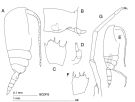 issued from : J.M. Bradford-Grieve in The Marine Fauna of New Zealand: Pelagic Calanoid Copepoda. National Institute of Water and Atmospheric Research (NIWA). New Zealand Oceanographic Institute Memoir, 102, 1994. [p.117, Fig.66]. Female: A, habitus (lateral right side); B, genital somite ( lateral right side); C, basipod 2 of P3; D, P5. Male: E, habitus (lateral right side); F, basipod 2 of P3; G, P5.
|
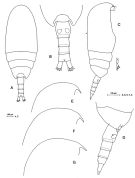 Issued from: M.G. Mazzocchi, G. Zagami, A. Ianora, L. Guglielmo & J. Hure in Atlas of Marine Zooplankton Straits of Magellan. Copepods. L. Guglielmo & A. Ianora (Eds.), 1995. [p.158, Fig.3.27.1]. Female (Central part of Straits of Magellan: off Cape Froward): A, habitus (dorsal); B, urosome (dorsal); C, habitus (lateral right side); D, urosome showing characteristic shape of spermatheque (lateral right side); E-G, differences in the curvature of the rostrum (lateral view). Nota: Proportional lengths of urosomites and furca 34:19:16:15:16 = 100. Points of distal segment of P5 smooth and lacking spinules.
|
 Issued from: M.G. Mazzocchi, G. Zagami, A. Ianora, L. Guglielmo & J. Hure in Atlas of Marine Zooplankton Straits of Magellan. Copepods. L. Guglielmo & A. Ianora (Eds.), 1995. [p.159, Fig.3.27.2]. Female (SEM preparation): A, habitus (dorsal); B, idem (lateral right side); C, forehead with rostral filaments; D, P5: E, detail of bifid terminal points of P5 distal segment. bars: A, B 0.100 mm; C 0.010 mm; D 0.050 mm; D 0.005 mm.
|
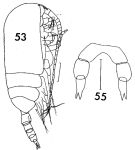 issued from : F.C. Ramirez in Contr. Inst. Biol. mar., Buenos Aires, 1969, 98. [p.50, Lam. VIII, figs.53, 55]. Female (from off Mar del Plata): 53, habitus (lateral right side); 55, P5. Scale bars in mm: 0.1 (53); 0.2 (55).
|
 issued from : B. Frost & A. Fleminger in Bull. Scripps Inst. Oceanogr. Univ. California, 1968, 12. [p.30, Table 2a]. Clausocalanus laticeps Females: Measurements and ratios *.
|
 issued from : B. Frost & A. Fleminger in Bull. Scripps Inst. Oceanogr. Univ. California, 1968, 12. [p.31, Table 2b]. Clausocalanus laticeps males: Measurements and ratios *. r = sample range; m = sample mean; n = number of specimens measured; s = sample standard deviation.
|
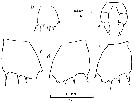 issued from : B. Frost & A. Fleminger in Bull. Scripps Inst. Oceanogr. Univ. California, 1968, 12. [p.153, Pl.26, b, c-e, f]. Female: b, basipodite 2 of P2; c-e, basipodite 2 of P3 (from different specimens); f, P5.
|
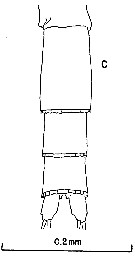 issued from : B. Frost & A. Fleminger in Bull. Scripps Inst. Oceanogr. Univ. California, 1968, 12. [p.155, Pl.27, c]. Male: c, urosome (dorsal).
|
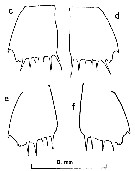 issued from : B. Frost & A. Fleminger in Bull. Scripps Inst. Oceanogr. Univ. California, 1968, 12. [p.157, Pl.28, c-d, e-f]. Male : c-d, basipodite 2 of P2; e-f, basipodite 2 of P3.
|
 issued from : B. Frost & A. Fleminger in Bull. Scripps Inst. Oceanogr. Univ. California, 1968, 12. [p.157, Pl.28, g]. Male: g, P5 (right lateral).
|
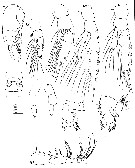 issue from : Heron G.A. & Bowman T.E. in Biology of the Antarctic Seas IV. Antarct. Res. Ser. Washington, 1971, 17. [p.158, Figs.100-109]. Female (from Antractic area): 100, habitus (lateral; scale bar: A); 101, genital field (scale bar: D); 102, right Md (scale bar: C); 103, left Mx1 (scale bar: D); 104, right Mxp (scale bar: C); 105-108, P1 to P4 (scale bar: C); 109, P5 (scale bar: B). All scales in mm.
|
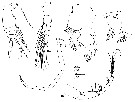 issue from : Heron G.A. & Bowman T.E. in Biology of the Antarctic Seas IV. Antarct. Res. Ser. Washington, 1971, 17. [p.158, Figs.110-115]. Male: 110, habitus (lateral; scale bar: A); 111, right Md (scale bar: C); 112, right Mx1 (scale bar: B); 113, left Mxp (scale bar: left Mxp (scale bar: C); 114, P1 (scale bar: C); 115, P5 (scale bar: C).
|
 Issued from : C. Séret in Thesis UPMC, Paris 6. 1979 [Pl. VII]. Female (from off N Kerguelen Is.): 31, Habitus (dorsal); 32, last thoracic segment and urosome (dorsal); 33, Basipod of P2; 34, basipod of P3; basipod of P2 (another individual); 36, basipod of P3 (other individual); 37, P5; 38, habitus (lateral (third individual); 39, prosome (dorsal view); 40, urosome (lateral) showing digestive tract and genital aerea. Nota: Cephalosome 1.6 times the total body length. Length of abdominal segments and caudal rami 39 : 18 : 13 : 13 : 17 = 100. Caudal rami about 2 times longer than wide. A1 shorter than the cephalosome length.
|
 Issued from : C. Séret in Thesis UPMC, Paris 6. 1979 [Pl. VIII, figs.41-43]. Female (from 50°S--56°S, 75°E-65°E): 41, basipod of P2; 42, basipod of P3: 43, P5.
|
 Issued from : C. Séret in Thesis UPMC, Paris 6. 1979 [p.54]. Female (from off N Kerguelen Is.): Relative lengths (%) of abdominal segments and furca (= caudal rami).
|
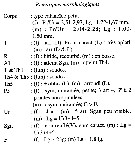 Issued from : C. Razouls in Ann. Inst. océanogr., Paris, 1994, 70 (1). [p.46]. Caractéristiqueq morphologiques de Clausocalanus laticeps femelle et mâle adultes. Terminologie et abbréviations: voir à Calanus propinquus. Nota: Le mâle peut être confondu avec Clausocalanus ingens, cette dernière espèce caractérisée par la longueur du corps; Pr/Sgn (6.,2). Les stades copépodites 1 à 5 sont décrits par Heron & Bowman (1971, p.145-156).
| | | | | Ref. compl.: | | | Hardy & Gunther, 1935 (1936) (p.147, Rem.); Bary, 1959 (p.14, Fig.5, Table 4, correlation T-S): Senô & al., 1963 a (p.4); Björnberg, 1973 (p.311, 385); De Decker, 1984 (p.315, 343: carte); 1984 a (p.155); Zmijewska, 1987 (tab.2a); Ward, 1989 (tab.2); Atkinson & al., 1990 (tab.1); Santos & Ramirez, 1991 (p.79, 80, 82); Shih & Young, 1995 (p.72); Atkinson & al., 1996 (p.1387, diel periodicity, feeding); Ansorge & al., 1999 (p.135, Table 2, abundance v.s. TS diagram); Atkinson & Sinclair, 2000 (p.46, 50, 51, 55, zonal distribution); Razouls & al., 2000 (p.343, tab. 3, 5, Appendix); Pakhomov & al., 2000 (p.1663, Table 2, transect Cape Town-SANAE antarctic base); Chiba & al., 2001 (p.95, tab.4); Hunt & al., 2001 (p.374, tab.1); Ward & al., 2003 (p.121, tab.4: as Eucalanus laticeps: lapsus calami); Hunt, 2004 (p.1, 47, 74, Table 3.2, 4.4, fig.4.7, 4.11, fig.5.10: seasonal abundance); Berasategui & al., 2005 (p.313, fig.2); Berasategui & al., 2005 (p.485, tab.1); Berasategui & al., 2006 (p.485: fig.2); Hunt & Hosie, 2006 (p.1182, seasonal succession, indicator); 2006 a (p.1203, tab.2, fig.8); Dias & Araujo, 2006 (p.41, Rem., chart); Tsujimoto & al., 2006 (p.140, Table1); Ward & al., 2007 (p.1871, Table 2, abundance); Ward & al., 2008 (p.241, Tabls, Appendix II ); Park & Ferrari, 2009 (p.143, Table 4, Appendix 1, biogeography from Southern Ocean)Takahashi & al., 2010 (p.317, Table 3, 4, figs.4, 5, 6, 7, 8); Ward & al., 2012 (p.78, Table B1, abundance); Thompson G.A. & al., 2012 (p.127, Table 2, 3); Sabatini & al., 2012 (p. 33, Table 3, abundance vs stations transect); Ojima & al., 2013 (p.1293, Table 2, 3, abundance); Lee D.B. & al., 2013 (p.1215, Table 1, abundance, composition); Ward & al., 2014 (p.305, Table 4, abundance in the ''Discovery'' Investigations in the 1930s); Kouwenberg & al., 2014 (p.290, biogeography, Map 7); Acha & al., 2020 (p.p.1, Table 3: occurrence % vs ecoregions, Table 5: indicator ecoregions). | | | | NZ: | 6 | | |
|
Carte de distribution de Clausocalanus laticeps par zones géographiques
|
| | | | | | | | |  issued from : W. Vervoort in B.A.N.Z. Antarctic Reseach Expedition, Reports - Ser. B, Vol. III, 1957 [Fig.9]. issued from : W. Vervoort in B.A.N.Z. Antarctic Reseach Expedition, Reports - Ser. B, Vol. III, 1957 [Fig.9].
Chart showing the geographical distribution (white triangle) in the seas surrounding the Antarctic continent.
Nota: In this chart the area frequented by whaling vessels has been hatched. The Antarctic circle (66°.5 S) has been drawn as a broken line. The numbers I to VI refer to the sectors into which the Antarctic seas are divided according to Mackintosh (1942) (after Vervoort, 1951). |
 issued from : B. Frost & A. Fleminger in Bull. Scripps Inst. Oceanogr. Univ. California, San Diego, 1968, 12. [p.44, Chart 4, a]. issued from : B. Frost & A. Fleminger in Bull. Scripps Inst. Oceanogr. Univ. California, San Diego, 1968, 12. [p.44, Chart 4, a].
Occurrence of C. laticeps in samples examined; closed circles represent samples examined; open circles represent samples in which adults were found; bars through open circles represent samples from which specimens were removed for measurements. |
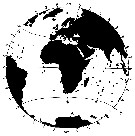 issued from : B. Frost & A. Fleminger in Bull. Scripps Inst. Oceanogr. Univ. California, San Diego, 1968, 12. [p.45, Chart 4, b]. issued from : B. Frost & A. Fleminger in Bull. Scripps Inst. Oceanogr. Univ. California, San Diego, 1968, 12. [p.45, Chart 4, b].
Occurrence of C. laticeps in samples examined; closed circles represent samples examined; open circles represent samples in which adults were found; bars through open circles represent samples from which specimens were removed for measurements. |
 issued from : C. de O. Dias & A.V. Araujo in Atlas Zoopl. reg. central da Zona Econ. exclus. brasileira, S.L. Costa Bonecker (Edit), 2006, Série Livros 21. [p.41]. issued from : C. de O. Dias & A.V. Araujo in Atlas Zoopl. reg. central da Zona Econ. exclus. brasileira, S.L. Costa Bonecker (Edit), 2006, Série Livros 21. [p.41].
Chart of occurrence in Brazilian waters (sampling between 22°-23° S).
Nota: sampling only 2 specimens. |
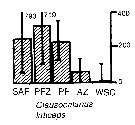 Issued from : A. Atkinson & J.D. Sinclair in Polar Biol., 2000, 23. [p.50, Fig.3] Issued from : A. Atkinson & J.D. Sinclair in Polar Biol., 2000, 23. [p.50, Fig.3]
Clausocalanus laticeps from Scotia Sea.
Median and interquartile ranges of copepods (nos /m2) in the five water zones; from north to south these are SAF Subantractic Front area, PFZ Polar frontal Zone, PF Polar Front area, AZ Antarctic Zone, WSC Weddell-Scotia Confluence area/ East Wind Drift.
Numbers on the plots are upper interquartiles where these could not be scaled. |
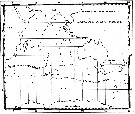 Issued from : C. Séret in Thesis 3ème Cycle, UPMC, Paris 6. 1979, Annexe. [p.26]. Issued from : C. Séret in Thesis 3ème Cycle, UPMC, Paris 6. 1979, Annexe. [p.26].
Geographical occurrences of Clausocalanus laticeps in the Indian Ocean and Antarctic zone. [after publications from: Brady, 1883, 1918; Thompson, 1900; Wolfenden, 1908, 1911; With , 1915; Rosendorn, 1917; Farran, 1929; Sewell, 1929, 1947; Brady & Gunther, 1935; Steuer, 1929, 1392, 1933; Ommaney, 1936; Vervoort, 1957; Tanaka, 1960; Brodsky, 1964; Seno, 1966; Andrews, 1966; Grice & Hulsemann, 1967; Seno, 1966; Frost & Fleminger, 1968; Voronina, 1970; Zverva, 1972].
C. Séret notes the occurrence at stations 56°S, 70°E; 51°,65°E and 50°S, 75°E !where the the number of individuals is very important in the latter station). |
 Issued from : J.H.M. Kouwenberg, C. Razouls & N. Desreumaux in Biogeographic Atlas of the Southern Ocean, Scient. Comm. Antarct. Res., Cambridge, 2014, 6.6. [p.293, Map 8]. Issued from : J.H.M. Kouwenberg, C. Razouls & N. Desreumaux in Biogeographic Atlas of the Southern Ocean, Scient. Comm. Antarct. Res., Cambridge, 2014, 6.6. [p.293, Map 8].
Distribution of Clausocalanus laticeps. |
| | | | Loc: | | | Antarct. (Amundsen Sea, Peninsula, Drake Passage, Scotia Sea, SW Atlant., Indian, Lützow-Holm Bay, SW Pacif.), sub-Antarct. (N South Georgia, SW & SE Atlant., off Prince Edward Is., Indian, SW & SE Pacif.), Magellan Strait, off S South Africa, Indian (subtropical convergence), off S New Zealand, SE North Island, Chile, SW Atlant. (Malvinas current, Patagonia, Mar del Plata), SE Atlant., Brazil (Vitoria-Cabo de Sao Tomé), China Seas (East China Sea, in Shih & Young, 1995, in Zhang & al., 2010) | | | | N: | 64 | | | | Lg.: | | | (25) F: 1,65-1,43; (30) F: 1,67-1,25; M: 1,1-1,01; (31) F: 1,55-1,5; (35) F: 1,65-1,32; (36) F: 1,49-1,27; (246) F: 1,45-1,1; (371) F: 1,55-1,35; M: 1,3-1; {F: 1,10-1,67; M: 1,00-1,30}
The mean female size is 1.445 mm (n = 14; SD = 0.1697), and the mean male size is 1.103 (n = 4; SD = 0.1391). The size ratio (male : female is about 0.76. | | | | Rem.: | épipélagique.
Sampling depth (Antarct., sub-Antarct.) : 500-700 m.
La présence de cette espèce dans la mer de Chine orientale nécessite confirmation.
Voir aussi les remarques en anglais | | | Dernière mise à jour : 03/04/2020 | |
|
|
 Toute utilisation de ce site pour une publication sera mentionnée avec la référence suivante : Toute utilisation de ce site pour une publication sera mentionnée avec la référence suivante :
Razouls C., Desreumaux N., Kouwenberg J. et de Bovée F., 2005-2025. - Biodiversité des Copépodes planctoniques marins (morphologie, répartition géographique et données biologiques). Sorbonne Université, CNRS. Disponible sur http://copepodes.obs-banyuls.fr [Accédé le 23 août 2025] © copyright 2005-2025 Sorbonne Université, CNRS
|
|
 |
 |

























